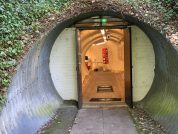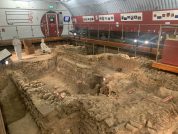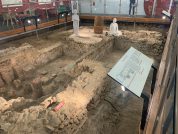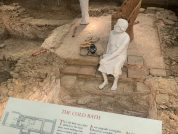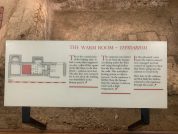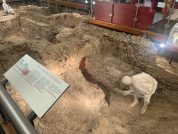Welwyn Roman Baths
Bath House and Villa
The Welwyn Roman Baths are a Roman ruin preserved under the A1(M) just north of modern-day Welwyn Garden City, Hertfordshire, England. The baths were a small part of the Dicket Mead villa, which was originally built in the 3rd century AD. The village of Welwyn has been described as being the site of a Romano-British settlement, where a Roman road crossed the river Mimram. There was another Roman villa near Welwyn on the Lockleys estate.
Excavating Welwyn Roman Baths
The full extent of the Dicket Mead villa was never fully excavated prior to the construction of the motorway, but the baths were only one of at least four buildings in total. The complex was probably part of a farm. It has been speculated that it might have been at least in part the equivalent of a hotel, lying as it does near Roman roads.
The ruins were uncovered in 1960 by local archaeologist Tony Rook, and the baths were gradually uncovered over the following 10 years by excavation. Shortly after the excavation was completed, the Ministry of Transport announced the route of a new motorway, straight over the top of the excavation.
Eventually arrangements were made whereby a steel vault would be built over the top of the baths with an access tunnel for the public. Once the vault was completed the motorway was built over the top of it, and the remains of the baths sit 9 metres below junction 6. Only about half of the original extent of the baths is now on display. Visible parts remaining include the hypocaust, the tepidarium (warm room), caldarium (hot room) and the frigidarium (cold room) floor and cold bath, constructed from opus signinum.
Once the vault was finished, the bulk of the remaining parts of the Dicket Mead villa were covered over by the roadworks. Archaeological material from the site is stored at Mill Green Museum, part of Welwyn Hatfield Museum Service, which also operates the baths. This stored material can be inspected by contacting the curator.
Welwyn Roman Baths
The building that housed the baths had an oven at the southern end of the central room suggests that this may have been a kitchen. The south eastern area was occupied by a small bath suite. This is some 15.5m long by 5m wide overall, with cold, warm and hot rooms and hot and cold plunge baths. The hot plunge bath is particularly interesting. In shape and size it resembles a modern bath, a style thought to be unknown elsewhere in Roman Britain. This bath suite is now preserved beneath the A1(M) and is included in the scheduling. It is a displayed monument open to the public at specific times. The remainder of the south western building and the connecting boundary wall were destroyed during the construction of the motorway and are not included in the scheduling.
Visiting the Baths
Half of the bath complex is on display which shows the layout of the cold, warm and hot rooms and the heating system which are remarkably well preserved. The baths are ingeniously preserved in a steel vault under the A1(M) motorway. You can find out how this vault was built. Also on display are archaeological finds from the Welwyn area and an exhibition devoted to the history of the site, which was uncovered during the 1960s and 70s by the Welwyn
Sites near Welwyn Roman Baths
- Dicket Mead Roman villa (0 km)
Villa - Welwyn Settlement (0 km)
Major Settlement - Lockleys Roman villa (0 km)
Villa - Wheathampstead Hillfort (6 km)
Iron Age Hillfort - Saint Albans (Verulamium) Fort (13 km)
Claudian Auxiliary Fort (AD 43–54) and Flavian Auxiliary Fort (AD 69–96) - St Albans (Verulamium) Theatre (13 km)
Theatres - St Albans (Verulamium) Roman Settlement (13 km)
British Capital and Flavian Auxiliary Fort (AD 69–96) - Verulamium Hypocaust and Mosaic (13 km)
Roman Houses - Gorhambury Rural Villa (14 km)
Villa - Park Street Villa (16 km)
Villa
